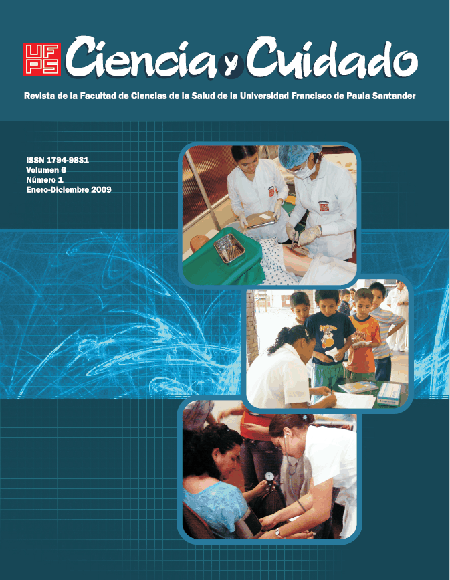Afrontamiento de las familias ante las consecuencias generadas en los pacientes que sufrieron trauma cráneo encefálico
Afrontamiento de las familias ante las consecuencias generadas en los pacientes que sufrieron trauma cráneo encefálico
Contenido principal del artículo
El Traumatismo craneoencefálico es la primera causa de muerte e incapacidad en la población < de 45 años, afectando principalmente a la población activa y originando terribles secuelas. La mayoría de las personas presentan diversos grados de discapacidad que los limitan para desempeñar los niveles de funcionalidad y 1 estilos de vida previos a la lesión.
Todas estas secuelas devienen un golpe arrollador para la familia y demanda una drástica variación y cambios en su funcionamiento habitual, el impacto es violento; cambia todo el sistema de prioridades y como todo evento estresante, está marcado por la incertidumbre y la ambigüedad. Presupone legitimar el indiscutible papel de la familia en la atención y afrontamiento por mantener, restablecer u optimizar la salud de cualquiera 2 de sus miembros durante el proceso de recuperación.
La realización de esta investigación cualitativa tiene como objetivo conocer las diferentes estrategias de afrontamiento empleadas por las familias ante las secuelas generadas en los pacientes que sufrieron trauma cráneo encefálico en el primer semestre de 2008, las cuales son una respuesta al cambio que requiere creatividad y producción de nuevas conductas, que le permitan a la familia obtener un grado de cohesión y adaptabilidad frente a las diversas problemáticas y cambios a lo largo del sistema familiar.
Palabras Clave: Estrategias de afrontamiento, secuelas.
SUMMARY
The TEC is 1ª cause of death and incapacity in the population < of 45 years, affecting mainly to the active populace and originating terrible sequels. Most of the people they present/display diverse degrees of discapacidad that limit s to carry out the previous levels of functionality and styles of life to the injury. All these sequels happen a sweeping blow for the family and demands a drastic variation and changes in their habitual operation, do not matter that age is a member of very outpost, or of a small boy in any case the impact is violent, changes all the system of priorities and each member will be overflowed by the overwhelming nonpredicted change and that, like all estresante event, it is marked by the uncertainty and the ambiguity. It estimates to legitimize to the unquestionable paper of the family in the attention and facing to maintain, to restore or to optimize the health of anyone of its members during the recovery process. The accomplishment of this qualitative investigation must like objective know the different strategies of facing used by the families before the sequels generated in the patients who underwent trauma encephalic skull in the first semester of 2008, which are an answer to the change that requires creativity and production of new conducts, that allow the family to in front of receive a rank of diverse cohesion and adaptability problematic and the changes throughout the familiar system.
Keywords: Sequels, coping strategies.
Descargas
Datos de publicación
Perfil evaluadores/as N/D
Declaraciones de autoría
- Sociedad académica
- Universidad Francisco de Paula Santander
- Editorial
- Universidad Francisco de Paula Santander
Detalles del artículo
ALDERMAN, N., Fry, R.K. y YOUNGSON, H.A. (1995). National Head Injury Foundation (NHIF-1989) Improvement of self-monitoring skills, reduction of behaviour disturbance and the dysexecutive syndrome: comparison of response cost and a new programme of self-monitoring training. Neuropsychological Rehabilitation, pág. 193-221.
ANDERSON, V.A., et al. (2005). Outcome 30 months after traumatic brain injury inIdentifying factors contributing to child and family. Neurol. Neurosurg. Psychiatry, 76, 401-408 Disponible en internet: www.medicrit.com/Revista/v2n7_05/V2N7_107.pdf pag. 1-21
ARRARAS Juan Ignacio y GARRIDO Emilio. El afrontamiento de la enfermedad. Servicio Navarro de Salud. UNED Pamplona. Hospital San Juan de Dios. Universidad Pública de Navarra Disponible en Internet: dialnet.unirioja.es/servlet/fichero.Pag.1-12.
LAZARUS, r.s. y FOLKMAN, s. (1984). Stress, Appraisal and Coping. New York: Springer Publishing Company. (Traducción española Estrés y procesos cognitivos, 1986, Barcelona: Martínez Roca. Disponible en Internet: www.medicrit.com/Revista/v2n7_05/V2N7_107.pdf pág. 1-8
MC CUBBIN h, LARSEN a. y OLSON, d. (1981). F COPES. Family Crisis Oriented Personal Evaluation Scales. Universityof Minnesota: St. Paul. Disponible en Internet portal web. ucatolica.edu.co/easyWeb2/acta/pdfs/v10n2/art-12_127-141.pdf –pag 1-31
MONTILLA Fernández Ana María. Jornadas de hepatitis c en valencia. ponencia "el paciente y la familia ante la enfermedad" 28 de junio de 2006 Disponible en internet http://www.aehc.es ág. 1-9
MORENO Pedro, BLANCO Carmen. Epidemiología y clasificación del daño cerebral. En Neuropsiquiatria del daño cerebral. Ed. I.Quemada; C.Pelegrin; J.M. Muñoz,1996.Ed.Prou Disponible en internet: www.medicrit.com/Revista/v2n7_05/V2N7_107.pdf pag1-5 .
ROCA Pérez m. apoyo Social. su significación para la salud humana. La Habana, Cuba: Editorial Félix Varela; 2000. Disponible en Internet: dialnet.unirioja. es/servlet/fichero. pag 1- 16.
ROY Callista. Modelos teóricos en enfermería. www.enfermeriajw.cl/teoristas/Callista_Roy2.ppt -1-8







